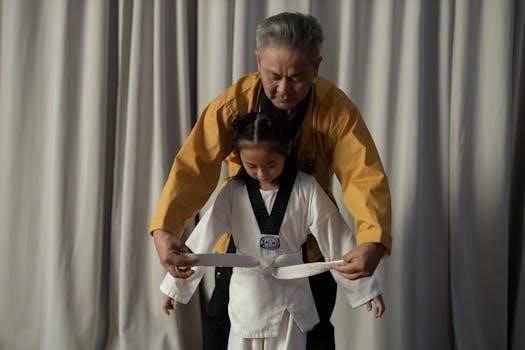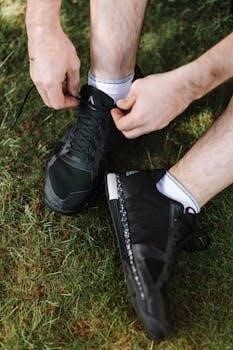
knot tying guide pdf
Knot Tying Guide PDF⁚ An Overview
This section provides a comprehensive introduction to knot tying․ The guide offers a basic overview, focusing on understanding the uses, development, and easy-to-use instructions․ It details step-by-step guidance alongside illustrations, ensuring quick and easy learning of knot-tying art․
Knot tying is a valuable skill applicable in various everyday situations, regardless of whether one is a mountain climber or not․ Understanding the purpose of each knot is as crucial as tying it, making it essential to learn the correct application of each type․
This guide offers a basic overview of essential knots, providing insights into their specific uses and step-by-step instructions for tying them effectively․ It covers fundamental techniques suitable for beginners, ensuring a solid foundation in knot tying․
The book will give the reader a basic overview of each knot, an understanding of its uses and development and an easy-to-use guide to tying it․
From joining ropes of similar thickness to first aid applications like tying bandages, this manual provides practical knowledge for various scenarios․ Mastery of these skills enhances problem-solving abilities and ensures preparedness in different environments․

Essential Knot Tying Techniques
This section outlines the fundamental techniques needed for tying knots․ Also, it covers general principles that govern the tying of all knots․ Speed in tying knots may affect strand placement․
Basic Knot Tying Terminology
Understanding knot tying requires familiarity with specific terms․ The “running end” is the active part of the rope used to form the knot․ A “loop” is created when the rope is bent back on itself, forming a closed curve․ A “hitch” refers to a knot that attaches a rope to another object, such as a ring or post;
The term “dressing” a knot means tightening and arranging the strands neatly to ensure it is properly formed and secure․ “Overhand knot” refers to a simple knot made by passing the running end over and then under the standing part of the rope․ “Standing part” is the inactive section of the rope․
Mastering these terms is crucial for effectively following knot-tying instructions and understanding the mechanics behind each knot․ This knowledge ensures safer and more reliable knot tying in various applications․
General Principles of Knot Tying
Successful knot tying hinges on adhering to several key principles․ First, always select the appropriate knot for the specific task․ Consider the load, material, and environmental conditions․ A poorly chosen knot can fail, leading to potential hazards․ Ensure the knot is properly “dressed” by tightening it carefully․ This process aligns the strands, maximizing strength and stability․
Use caution when tying knots, especially with slippery materials․ Maintain adequate tension to prevent slippage․ Regularly inspect knots for wear or damage, replacing them when necessary․ Practice knot tying to improve speed and accuracy, but never compromise on quality․ Understanding these principles ensures reliable and safe knot usage in all situations․
The speed in tying knots should not come at the expense of proper placement․

Types of Knots and Their Uses
Knots are classified into four main groups․ These include end-of-rope knots, anchor knots, middle-of-the-rope knots, and specialized knots․ Each category serves distinct purposes, fulfilling various needs in different applications․
End of the Rope Knots
End-of-the-rope knots form a crucial class, serving various essential functions․ These knots are primarily designed to prevent fraying, provide a secure grip, or create a stopping point on the end of a rope․ A simple overhand knot is a fundamental example, easy to tie and effective in preventing a rope from unraveling․
The Ashley stopper knot is another notable example, offering a more substantial and reliable end knot․ Anglers loops are also included, providing a secure loop at the rope’s end, often used in fishing․ These knots are critical in various applications, ensuring safety and functionality․
These knots are easy to use guide to tying it․ They are essential for anyone working with ropes, from outdoor enthusiasts to professionals․ They are designed to provide security and prevent accidents, making them indispensable in many situations․ The specific knot chosen will depend on the particular application and desired strength․
Anchor Knots
Anchor knots are essential for securing a rope to a fixed object, providing a reliable and sturdy connection․ These knots are designed to withstand significant loads and maintain their integrity under tension․ A well-tied anchor knot is crucial for safety in various applications, including climbing, sailing, and construction․
Round Turn and Two Half Hitches is a common anchor knot, known for its strength and stability․ It involves passing the rope around the anchor object twice, then securing it with two half hitches․ This configuration distributes the load evenly, reducing the risk of slippage or failure․
Selecting the appropriate anchor knot depends on the specific application, the type of rope, and the nature of the anchor point․ Proper tying technique is essential to ensure the knot’s strength and reliability․ Regular inspection of anchor knots is also crucial to identify any signs of wear or damage, ensuring continued safety and effectiveness․
Middle of the Rope Knots
Middle of the rope knots are designed to create a loop or connection point within the span of a rope, without needing access to either end․ These knots are valuable in various scenarios where you need to attach something to the middle of a rope or create a secure loop for specific purposes․
One common example is the Alpine Butterfly knot, renowned for its strength and ability to withstand multidirectional loads․ It forms a reliable loop that can be used for attaching carabiners or creating a secure anchor point․ The knot’s structure ensures it remains stable even under tension from different angles․
Another useful knot in this category is the Figure Eight Loop․ It provides a strong and easily identifiable loop in the middle of the rope․ These knots are useful in rescue situations where you might need to create a secure attachment point quickly and efficiently․ Understanding how to tie these is essential․
Special Knots
Special knots serve niche purposes beyond the common categories․ These knots often combine unique features for specific tasks․ One notable example is the Sheet Bend, designed for joining two ropes of different thicknesses․ Its structure ensures a secure hold even when the ropes vary significantly in diameter, making it useful in diverse situations․
Another specialized knot is the Carrick Bend, known for its decorative appearance and strength․ It is often used in nautical settings and can serve as a reliable way to join two ropes․ The Carrick Bend’s symmetrical design distributes tension evenly, enhancing its stability and preventing slippage․
The Bowline on a Bight creates a secure loop that does not constrict, making it ideal for rescue scenarios or hoisting applications where a non-tightening loop is essential․ Mastering these will expand your knot-tying capabilities․

Specific Knot Instructions
This section offers detailed, step-by-step instructions for tying specific knots․ Clear guidance is provided, ensuring ease of learning․ Illustrations are included to aid understanding and proper execution of each knot-tying technique․
Tying the Square Knot
The square knot, primarily used to join two ropes of similar thickness, is a fundamental knot for various applications․ Its secure nature makes it suitable for first aid, such as tying bandages, and everyday tasks like securing boot or shoe laces․
To tie a square knot, begin by holding one rope in each hand․ Cross the right rope over the left, then pass it under and pull tight․ Next, cross the left rope over the right and again pass it under and pull tight․ Ensure the knot is dressed neatly to avoid slippage․
A properly tied square knot should lie flat, with the two ropes exiting the knot on the same side․ It’s crucial to remember that while useful, the square knot is not recommended for critical applications where safety is paramount․ An incorrectly tied square knot can slip under tension, leading to potential failure․ Always double-check the knot’s integrity before relying on it․
Tying Hitches⁚ Clove Hitch and Cow Hitch
Hitches are essential for attaching a rope to an object, and the clove hitch and cow hitch are two fundamental examples․ The clove hitch provides a simple way to secure a rope around a post or ring․ To tie it, wrap the rope around the object, cross it over itself, wrap it around the object again, and tuck the end under the second wrap․
The cow hitch, also known as a lark’s head, is used to attach a rope to an object with a loop․ Fold the rope to create a loop, pass the loop around the object, and then pass the ends of the rope through the loop․
Both hitches are quick to tie but may slip under heavy or fluctuating loads․ Ensuring the hitches are properly tightened and dressed is crucial for their effectiveness․ Consider using alternative knots for critical applications․

Resources for Learning Knot Tying
Explore various resources for mastering knot tying, including manuals and guides․ These provide step-by-step instructions and illustrations to enhance your skills in identifying, tying, and utilizing different knots effectively․
Knot Tying Manuals and Guides
Delve into a wealth of knowledge with knot tying manuals and guides․ These resources offer comprehensive instructions and detailed illustrations, making it easier to learn the art of knot tying․ A good manual gives a basic overview of each knot, an understanding of its uses and development, and an easy-to-use guide to tying it;
Many knot tying guides provide step-by-step instructions and detailed illustrations, allowing you to learn quickly and easily․ These resources cover essential knots for outdoor pursuits and everyday life․ They explain when and why you should use a particular knot․
Whether you are a beginner or an experienced knot tyer, knot tying manuals and guides can help you improve your skills․ They typically include explanations of basic techniques, equipment needed, and the general principles that govern knot tying, regardless of the suture materials․
From simple overhand knots to more complex hitches, these manuals offer valuable insights and practical advice․ With clear diagrams and concise explanations, learning to tie knots becomes an enjoyable and rewarding experience․